Outsourcing software development: How to choose the right partner
Why companies outsource software development
Many businesses reach a point where custom software becomes more than just “nice to have” - it’s a core part of delivering value to customers, supporting internal workflows, or standing out in the market. But building everything in-house isn’t always practical. That’s where outsourcing enters the picture. Outsourcing software development means hiring an external team to design, build, maintain or enhance software, rather than doing all of it within your company. It allows you to tap into external expertise, scale teams up or down, and focus on your core business. Still, choosing the right partner is critical. Pick a poorly aligned vendor and you risk wasted time, cost overruns, delays, or low quality. Get it right and you gain a trusted extension of your team that accelerates your goals.
In this post I’ll walk you through what you need to consider in plain, non-technical language in order to pick a partner who suits your project, your culture and your future.
Main types of software development outsourcing
Today, the world feels like one big connected village. Businesses can easily reach out to talented software development teams from all over the globe. With so many outsourcing companies available, you have a wide range of choices - from different collaboration styles to diverse locations that fit your goals and budget.
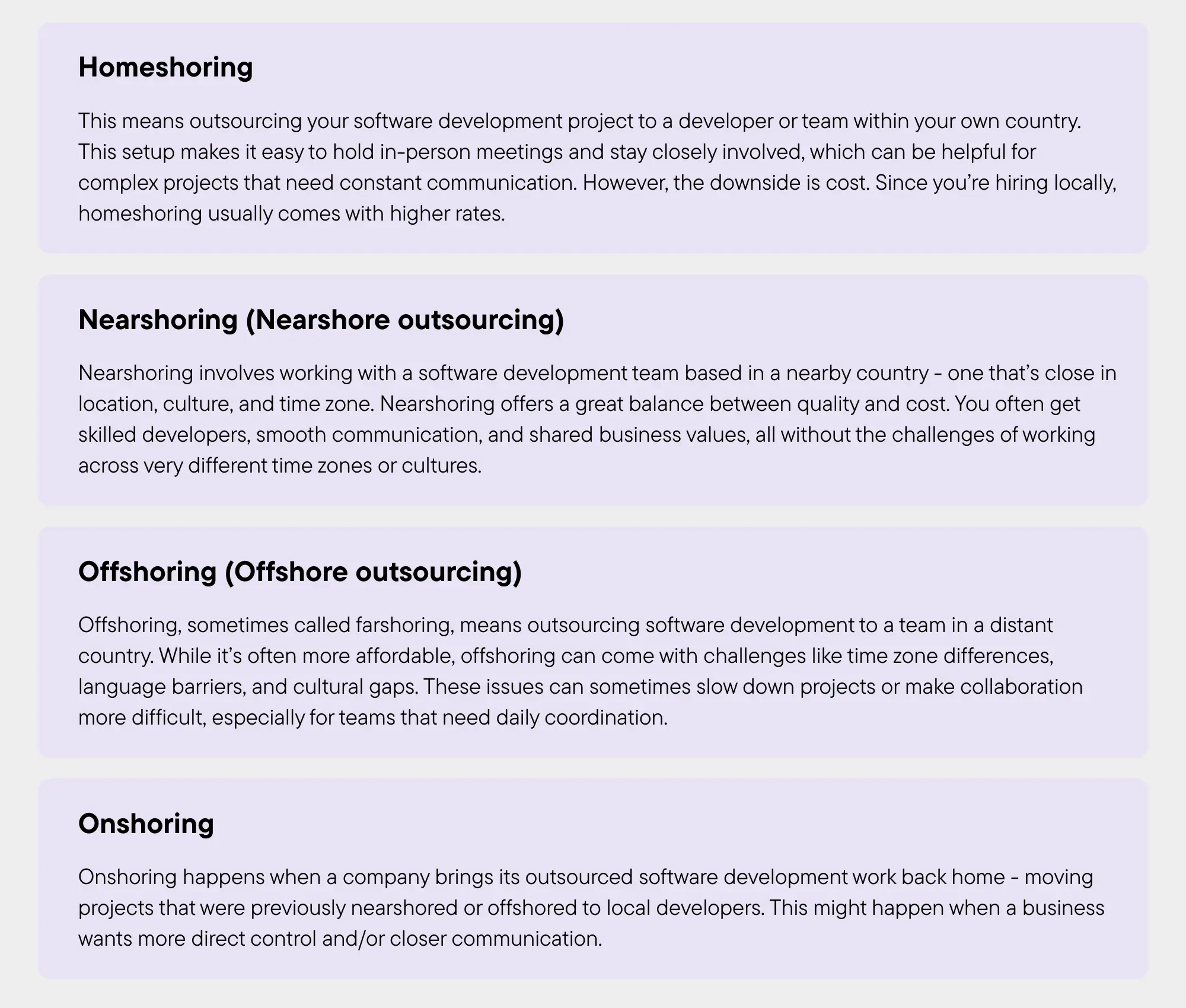
Businesses around the world use different outsourcing models depending on their goals, budgets, and project needs. Here are the main ones to know about:
Homeshoring
Homeshoring means outsourcing your software development project to a developer or team within your own country - sometimes even within the same city. This setup makes it easy to hold in-person meetings and stay closely involved, which can be helpful for complex projects that need constant communication. However, the downside is cost. Since you’re hiring locally, homeshoring usually comes with higher rates compared to other options.
Nearshoring (Nearshore outsourcing)
Nearshoring is one of the most popular outsourcing models today. It involves working with a software development team based in a nearby country - one that’s close in location, culture, and time zone. Companies love nearshoring because it offers a great balance between quality and cost. You often get skilled developers, smooth communication, and shared business values, all without the challenges of working across very different time zones or cultures.
Offshoring (Offshore outsourcing)
Offshoring, sometimes called farshoring, means outsourcing software development to a team in a distant country - for example, India, China, or the Philippines. While it’s often more affordable, offshoring can come with challenges such as time zone differences, language barriers, and cultural gaps. These issues can sometimes slow down projects or make collaboration more difficult, especially for teams that need daily coordination.
Onshoring
Onshoring happens when a company brings its outsourced software development work back home - moving projects that were previously nearshored or offshored to local developers within the same country. This might happen when a business wants more direct control, closer communication, or to take advantage of a new partnership opportunity nearby.
Different models of software development outsourcing
The types of software development outsourcing mentioned above are based on where your development team is located. Now, let’s explore the different ways your project can actually be managed and delivered.
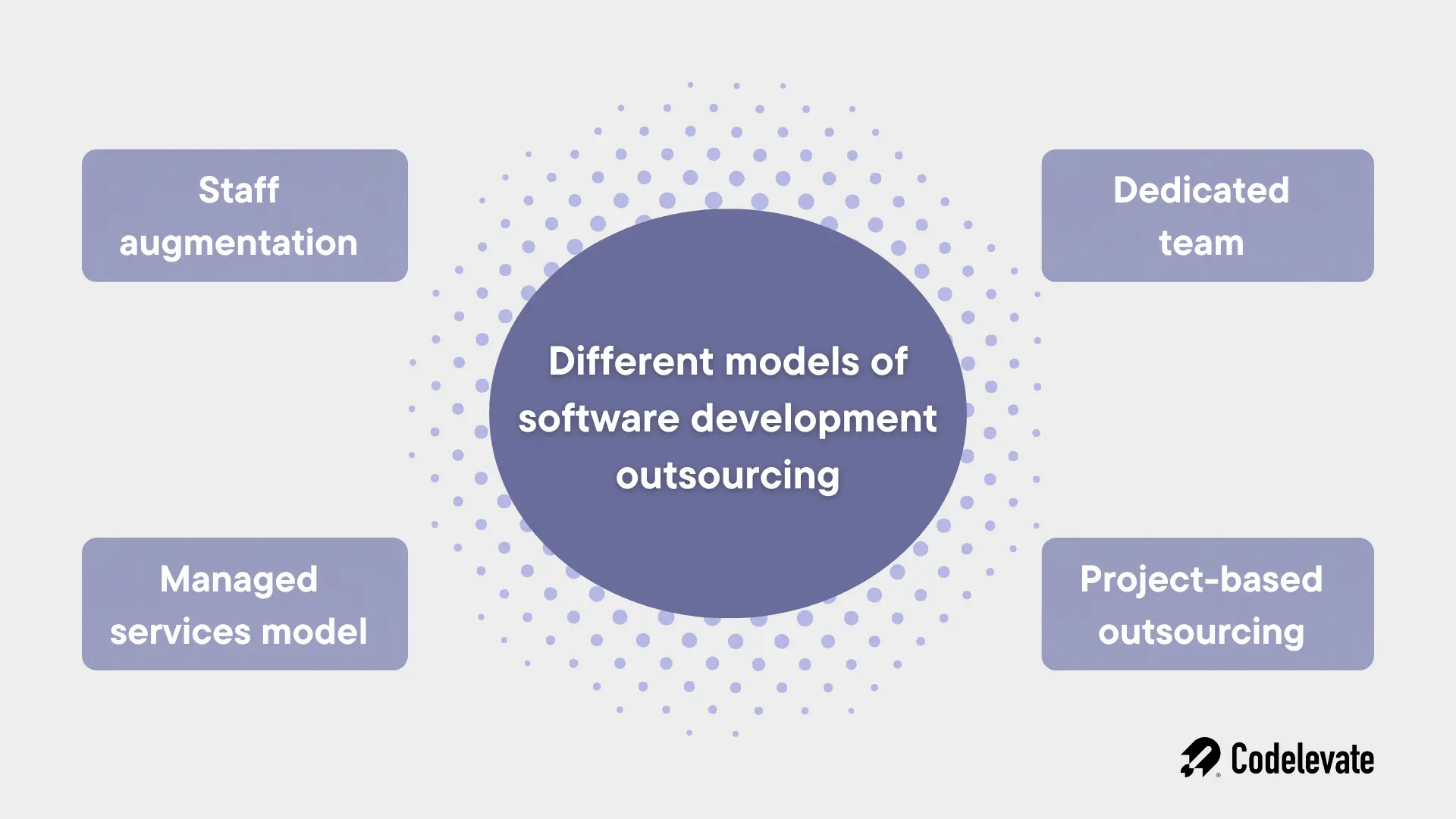
The types of software development outsourcing mentioned earlier can also be grouped based on how your project is managed and who retains control. Below are the four most common outsourcing models that businesses use to build or scale their development capabilities.
1. Staff augmentation
In the staff augmentation model, your company extends its in-house team with remote software engineers provided by an outsourcing partner. The provider handles recruitment, administration, and infrastructure, while you retain control over team composition, management, and workflow. This setup is ideal when you want to scale your team quickly without losing direct oversight of your project’s progress and culture.
2. Dedicated team
In this model, the outsourcing provider assembles a dedicated team that works exclusively on your project. The team often remains consistent across ongoing or future collaborations, ensuring deep product knowledge and efficiency. The provider typically manages day-to-day operations, HR, and delivery, while you focus on aligning business goals and priorities. It’s a great choice for long-term projects that require stable, committed resources.
3. Managed services model
The managed services model represents a more strategic partnership rather than a simple client–vendor relationship. Here, the outsourcing company takes full responsibility for the project or a specific function, managing the team, process, and performance outcomes. This approach allows your organization to focus on its core business activities while benefiting from your partner’s expertise, innovation, and ability to drive measurable business results.
4. Project-based outsourcing
This is one of the most common and straightforward outsourcing arrangements. You define the project scope, goals, and timeline, and the outsourcing provider takes care of the rest - from development to delivery. Once the project starts, the vendor’s team operates largely independently, providing updates and progress reports along the way. This model works best for clearly defined projects with fixed requirements and deadlines.
The benefits of software outsourcing services in 2026
Software outsourcing services bring a wide range of advantages to businesses of all sizes - from startups aiming to grow quickly to enterprises optimizing efficiency. Below are some of the most impactful benefits companies experience when partnering with an outsourcing provider.
1. Cost efficiency
One of the most recognized benefits of outsourcing is cost reduction. By outsourcing software development, businesses can avoid expenses related to full-time in-house teams, such as salaries, benefits, training, office space, and equipment. Partnering with developers in regions where labor costs are lower can lead to substantial savings without compromising quality. According to recent outsourcing cost comparison data, companies can save between 30–60% in total project costs, depending on location and project scope.
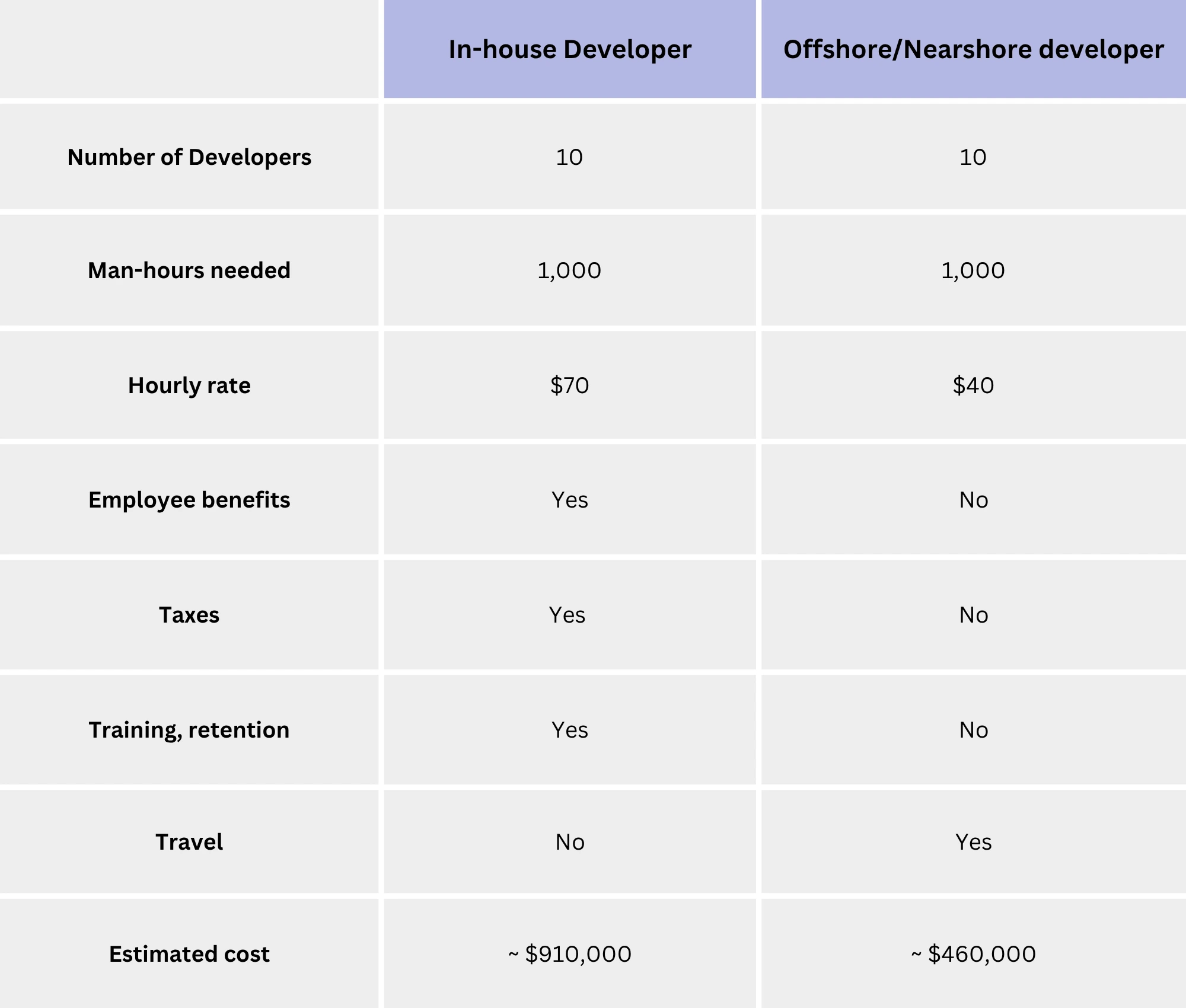
Sample cost savings from outsourcing; Source: Deloitte Global Outsourcing Survey 2024
2. Access to a global talent pool and fresh perspectives
Outsourcing opens doors to a vast global network of skilled professionals. This gives companies access to specialized expertise that might be scarce or unavailable locally - from AI engineers to UX designers. Moreover, outsourcing teams often bring diverse experiences and innovative ideas shaped by working with different industries and technologies. This external perspective can inspire creative solutions and process improvements that internal teams might overlook.
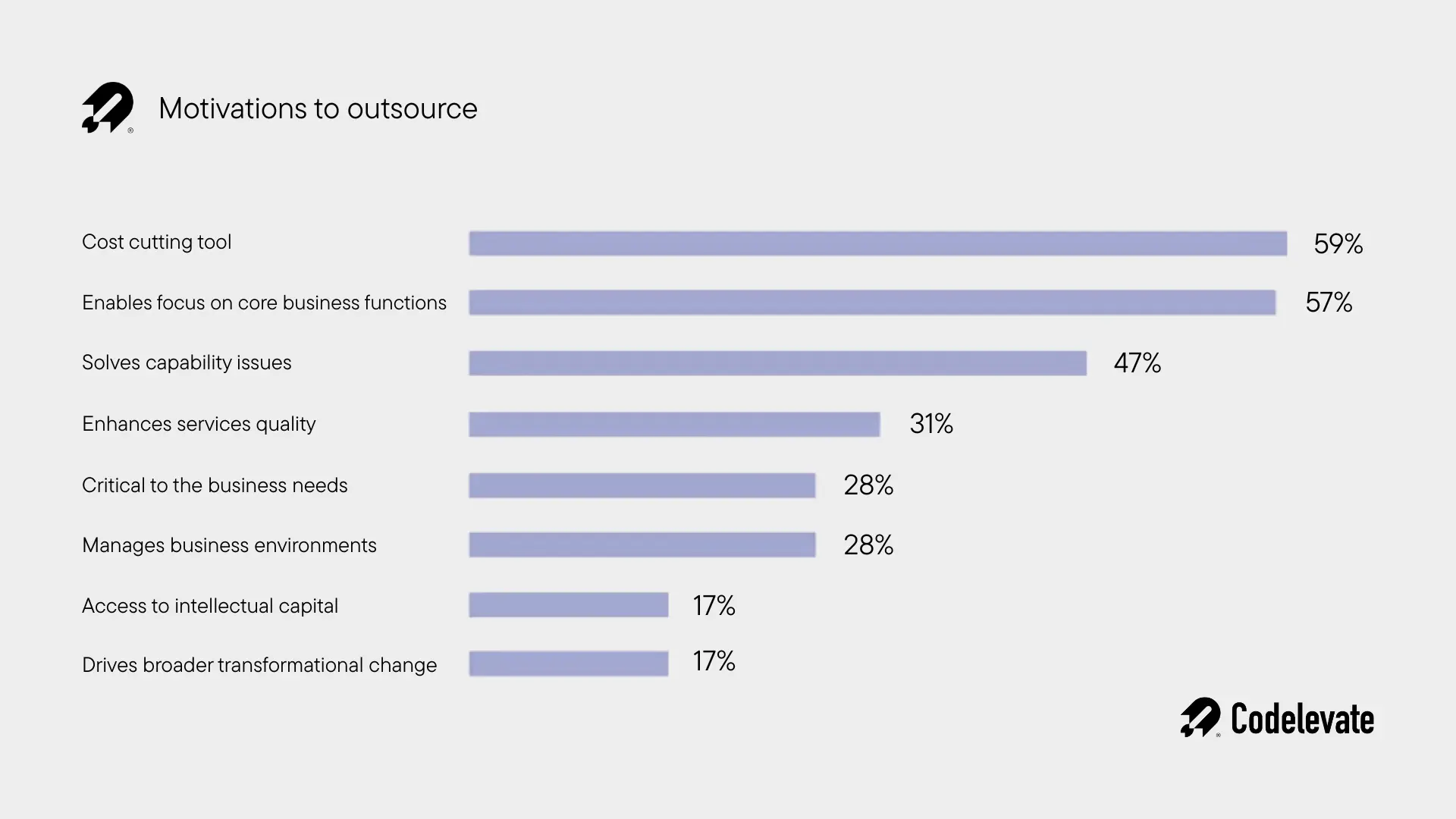
3. Scalability and flexibility
With outsourcing, scaling your development resources becomes quick and seamless. You can easily expand or reduce team size based on your project’s current stage or business demands - without the administrative burden of hiring or layoffs. This flexibility is particularly valuable for companies facing fluctuating workloads, seasonal demands, or rapid product rollouts. It helps you stay agile and responsive to market changes while keeping costs predictable.
4. Focus on core business
By delegating software development tasks to external experts, your in-house teams can concentrate on what matters most - driving strategy, innovation, and customer engagement. Outsourcing reduces operational distractions, allowing leaders to focus on core business goals and long-term growth. In short, you gain more time to innovate while your partner handles the technical execution.
5. Access to the latest technologies
Top outsourcing providers continuously invest in learning and adopting the newest tools, frameworks, and best practices. Partnering with them gives you immediate access to modern technologies, from cloud computing to AI-driven automation, without the need to spend on costly upskilling or infrastructure upgrades. This keeps your business technologically competitive and future-ready.
6. Risk mitigation
Working with experienced outsourcing partners helps reduce risks associated with project delays, quality issues, or operational bottlenecks. Established vendors typically follow standardized processes, strict quality assurance protocols, and contingency plans, ensuring stability and reliability at every development stage.
7. Continuous support and maintenance
Outsourcing doesn’t end with project delivery. Many providers offer ongoing support and maintenance packages that cover updates, performance monitoring, and security enhancements. This ensures your software stays up-to-date, optimized, and protected long after launch, giving you peace of mind and long-term value.
Outsourcing software development in 2026: Step-by-step guide
Step 1: Be sure you need outsourcing
Before jumping into vendor search, take a moment to ask: do we really need to outsource?
- Are we lacking internal resources (skills, time, people) to build what we need?
- Will the software project distract us from our core business if we try to do it in-house?
- Is the budget realistic? The timeline clear?
- If you answer yes to these, outsourcing could make sense. But if your project is small, your in-house team is capable and you can handle the work, it may be simpler (and sometimes cheaper) to stay internal.
Also do some upfront work: define your project goals, key features, rough timeline and budget. A clear brief helps both you and your future partner.
Step 2: Define what you really want
Once you’ve decided to outsource, clearly define what you want.
- What is the core outcome? For example: “We want a mobile app that helps users track X” rather than “we want an app.”
- What are the must-have features and what are nice-to-haves?
- What systems need to integrate? What user needs must be met?
- What budget range and timeline are we comfortable with?
- Being precise here helps you evaluate vendors more fairly, get realistic proposals and avoid surprise costs or delays.
Step 3: Set your criteria for choosing a partner
To pick the right partner, you’ll want to compare candidates across a few key dimensions. Here are important criteria to use:
Expertise & portfolio
Does the vendor have experience working on projects similar to yours? If you’re building a web-platform with many users, you’ll want someone who has done that before. Check their portfolio, ask for case studies, and ask about how they handled challenges.
Communication & culture fit
Even if the vendor is technically strong, poor communication or cultural mismatch can cause big problems. Ask: how do they keep you updated? What is their time zone, language fluency, responsiveness like? Do they seem proactive and transparent?
Process & methodology
Does the partner use a development methodology (like Agile) that fits with your way of working? Do they use tools (like project-tracking, task boards, reporting) you understand? A structured process helps avoid chaos.
Pricing & contract terms
Does the vendor explain how they price work (fixed-price vs time & materials)? Are deliverables, milestones, changes, and intellectual property clearly laid out? Hidden costs are a common pitfall.
Long-term support & scalability
If your plan is not just one release but ongoing updates, you’ll want someone who can scale with you. Also ask about post-launch support: who fixes bugs, how are updates handled?
Step 4: Evaluate vendors and shortlist
With your criteria in hand, you can reach out to potential partners and build a shortlist. Here are steps to follow:
- Send a request for information (RFI) or request for proposal (RFP) detailing your project: goals, important features, timeline, budget.
- Ask each vendor to provide references, relevant case studies and details of how they handled similar work.
- Interview the team: ask about how they would approach your project, what risks they see, how they communicate.
- Have a small trial task if possible. That gives you a low-risk way to see how they work in practice.
During this process watch for red flags: vague proposals, unrealistic timelines, no clarity on deliverables, poor responsiveness.
Step 5: Select contract model and set expectations
Once you pick a partner, agree contract terms and expectations clearly. Some things to lock down:
- Deliverables and milestones: what will be delivered, when, and how you’ll accept it.
- Ownership: who owns the code, how IP is handled.
- Pricing model: is it fixed-price, hourly/time & materials, or target cost? Understand what happens if scope changes.
- Communication frequency: how often you’ll get updates, how changes are managed.
- Exit/transition plan: if you want to move the work elsewhere, how will the hand-over happen?
By setting everything clearly, you build trust and reduce surprises.
Step 6: Begin the work and manage the partnership
Outsourcing doesn’t mean you can fully “set and forget” — you still need active oversight to make the relationship work.
- Appoint a single point of contact on your side to work with the vendor (for decisions, clarifications).
- Hold regular check-ins: progress, blockers, next steps.
- Use project tracking tools to monitor tasks, timeline, quality.
- Provide timely feedback: respond quickly when the partner asks you questions or proposes changes.
- Stay open to suggestions: a good partner will bring ideas and improvements you hadn’t thought of.
By staying engaged you get the most value and help the team deliver what you need.
Step 7: Monitor, review and adapt
As the project progresses:
- Compare progress against your milestones and deliverables.
- Ask for short demos or iterations so you can see and test what’s been built.
- Keep an eye on budget and scope creep — changes add cost, and your partner should help you understand trade-offs.
- Ensure quality checks are being done (testing, user feedback).
- After each major phase, review what went well / what didn’t — this helps improve future collaboration.
If you find issues, raise them early. It’s better to adjust sooner than let problems accumulate.
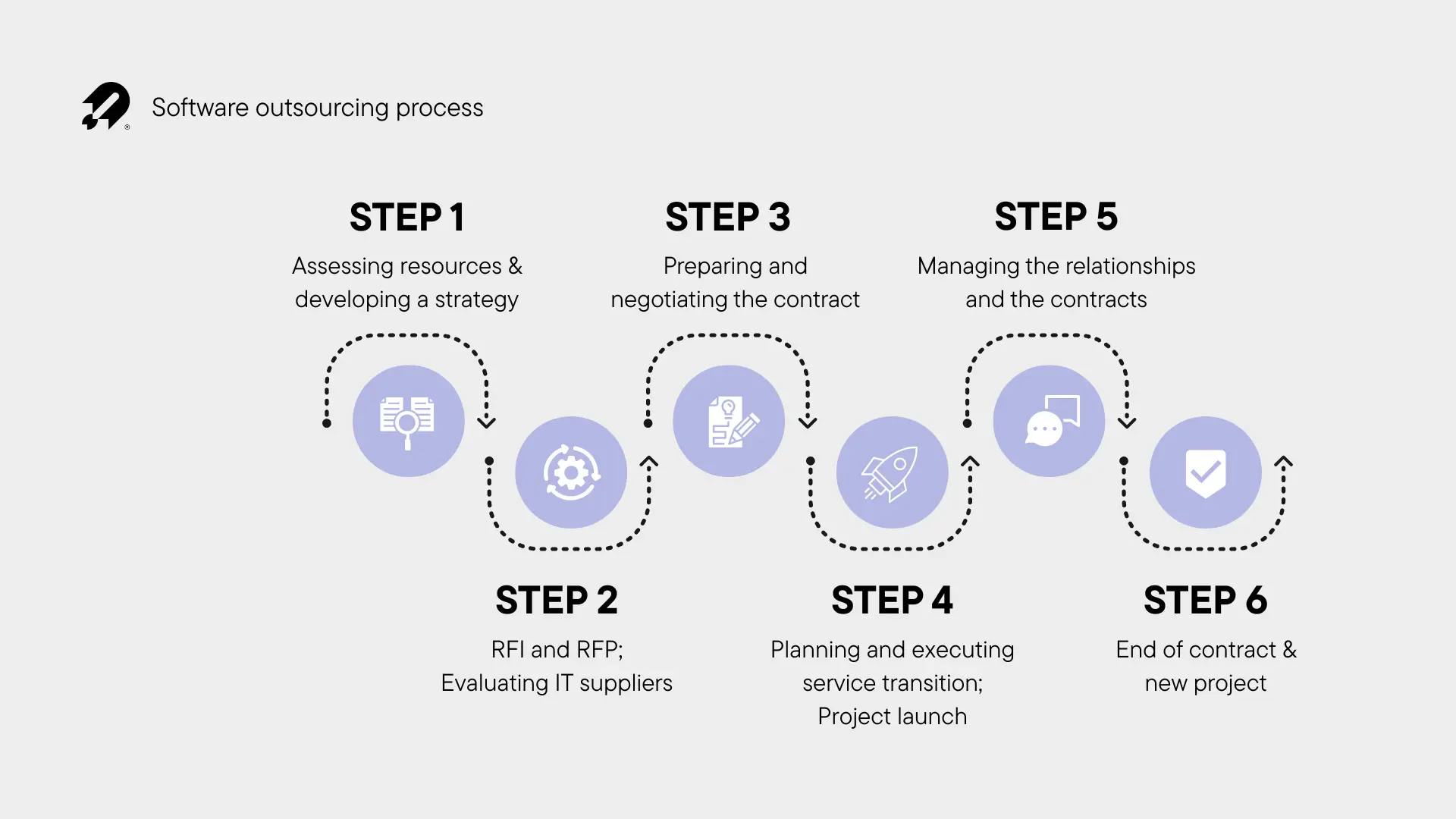
Key mistakes many businesses make
Here are some common pitfalls to avoid:
- Choosing purely on cost. The cheapest partner may look appealing but often lacks experience, process or communication.
- Vague or shifting requirements. Without clarity you’ll open the door to misalignment, scope creep and delays.
- Ignoring culture and communication. Time zone differences, language issues or cultural mismatch often cause friction.
- No contract or unclear terms. Without ownership defined, you may face source-code or IP issues.
- Over-looking post-launch support. The build is only part of the journey: maintenance, updates and fixes matter too.
By being aware of these, you can steer clear of common traps.
Checklist: What to ask your outsourcing partner
Here’s a handy checklist you can use when evaluating potential suppliers:
- Have you done projects similar in industry/scale to mine? Can you share case studies?
- Which people will be working on my project? What are their roles?
- What is your development process/methodology (e.g., Agile, Scrum)?
- Which tools do you use for project tracking, communication, version control?
- What is the pricing model? What happens if we change scope?
- How do you handle delays, risks or changes?
- Who owns the final source code? What IP rights are transferred?
- How often will you report to us and how?
- What happens after launch? Do you provide support, updates, bug fixes?
- What are your time zone, language capacity and work hours relative to our location?
Use these questions to compare vendors head-to-head and pick the one that gives you confidence.
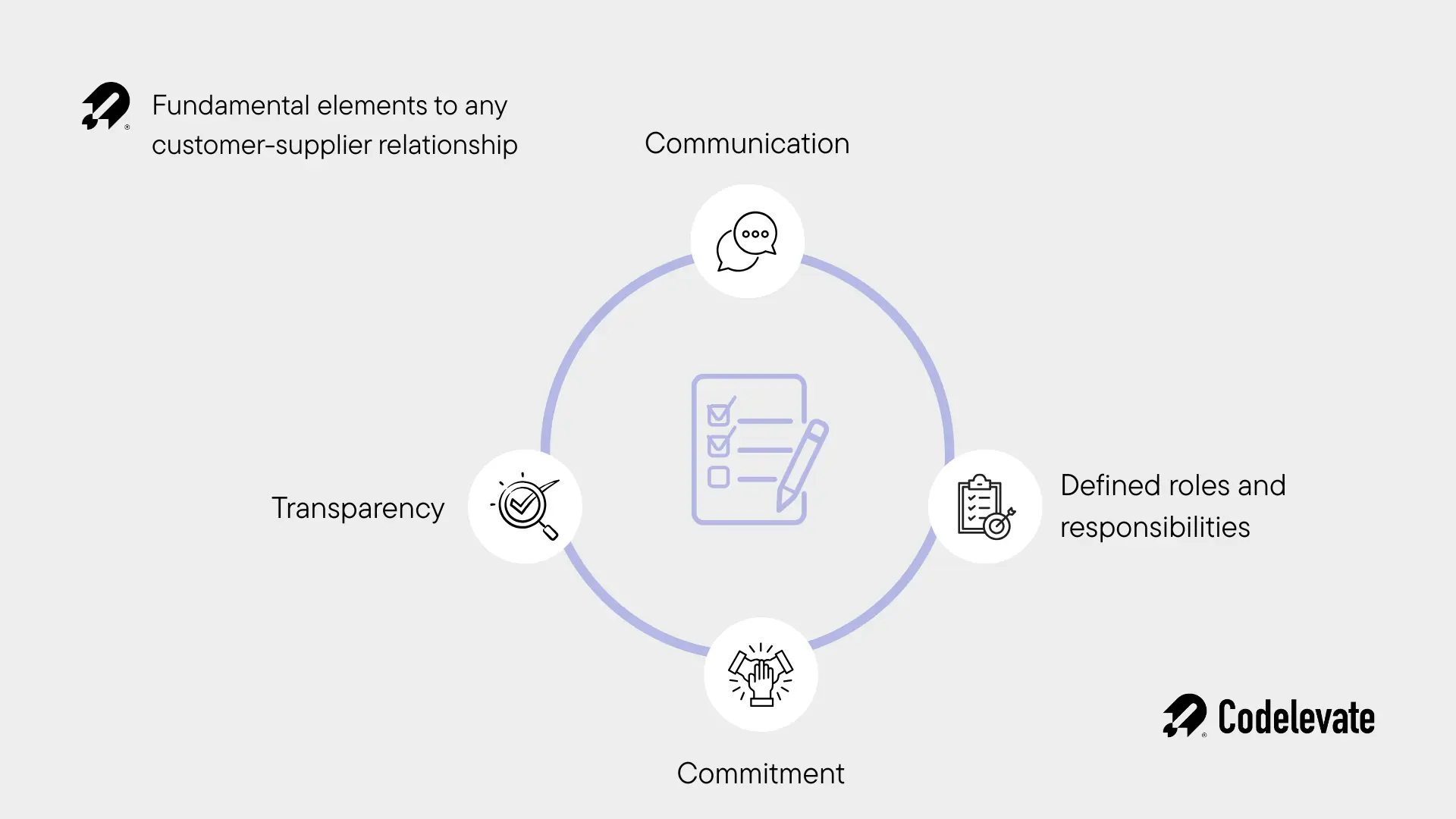
Why location matters: Onshore, nearshore or offshore
Where your partner is located matters. Here’s a quick breakdown:
- Onshore (same country): easiest communication, same time zone, cultural alignment — but often higher cost.
- Nearshore (nearby country): trade-off between cost and alignment, easier travel and time zones than far-off locations.
- Offshore (distant country): often lowest cost, but may require more effort on communication, cultural fit and time-zone overlap.
Whichever you choose, make sure you’re comfortable with how you’ll collaborate.
The best countries for software outsourcing
When it comes to software development outsourcing, the Netherlands and Bulgaria have both become standout destinations in Europe for their unique mix of talent, accessibility, and innovation culture.
The Netherlands
The Netherlands is known for its strong digital infrastructure, business-friendly environment, and tech-savvy workforce. With English proficiency among the highest in the world and a long history of international collaboration, Dutch developers and tech firms are perfectly equipped to work with global clients. The country’s strategic location in Western Europe offers overlapping time zones with nearly all of Europe and even parts of the U.S., making communication seamless. Dutch universities also rank among the top in Europe for computer science and engineering, producing a steady stream of skilled graduates ready for the global tech market. According to Statista’s European software development industry data, the Netherlands consistently ranks as one of the top countries in tech innovation and digital competitiveness.
Bulgaria
Bulgaria, on the other hand, combines affordability with exceptional technical expertise, making it one of Eastern Europe’s best-kept outsourcing secrets. The country has a rapidly growing IT sector and a workforce known for strong programming skills, analytical thinking, and multilingual ability. Bulgarian developers often rank high in global coding competitions and have experience working with international clients across fintech, healthcare, and enterprise software. Moreover, Bulgaria’s government actively supports the tech industry with favorable tax policies and innovation incentives, while maintaining some of the lowest operating costs in the EU. As shown in Statista’s IT outsourcing statistics for Bulgaria, the country’s tech exports and developer base have grown steadily year after year, solidifying its reputation as a reliable, high-quality outsourcing hub.
Want to dive deeper? Check out our practical guides on IT outsourcing in the Netherlands and IT outsourcing in Bulgaria.
How to scale the partnership for the long term
If this initial project goes well, you may want to build a longer-term relationship with your partner. To do that:
- Treat the vendor as a partner, not just a supplier — involve them in planning, strategy, next-phase ideas.
- Build shared knowledge: invite them to regular business updates so they understand your vision.
- Set evolving KPIs and shared goals: as your project grows, your partner should grow too.
- Keep reviewing the relationship: what could be improved? How can we be more efficient together?
A strong, long-term partner reduces the cost of onboarding new teams and helps you move faster.
Conclusion
Choosing the right software development outsourcing partner in 2026 is a strategic decision that can make or break your custom software project. Done right, it brings expertise, speed, flexibility, and focus. Done wrong, it can lead to delays, cost overruns, and unnecessary frustration. Start with a clear understanding of why you’re outsourcing and what you need. Then, assess potential partners based on technical expertise, cultural alignment, processes, communication style, and contract clarity. Actively manage the project, monitor progress and costs, and treat your vendor as a true partner. With the right approach, outsourcing isn’t just a cost-cutting move - it becomes a powerful driver of growth and innovation.
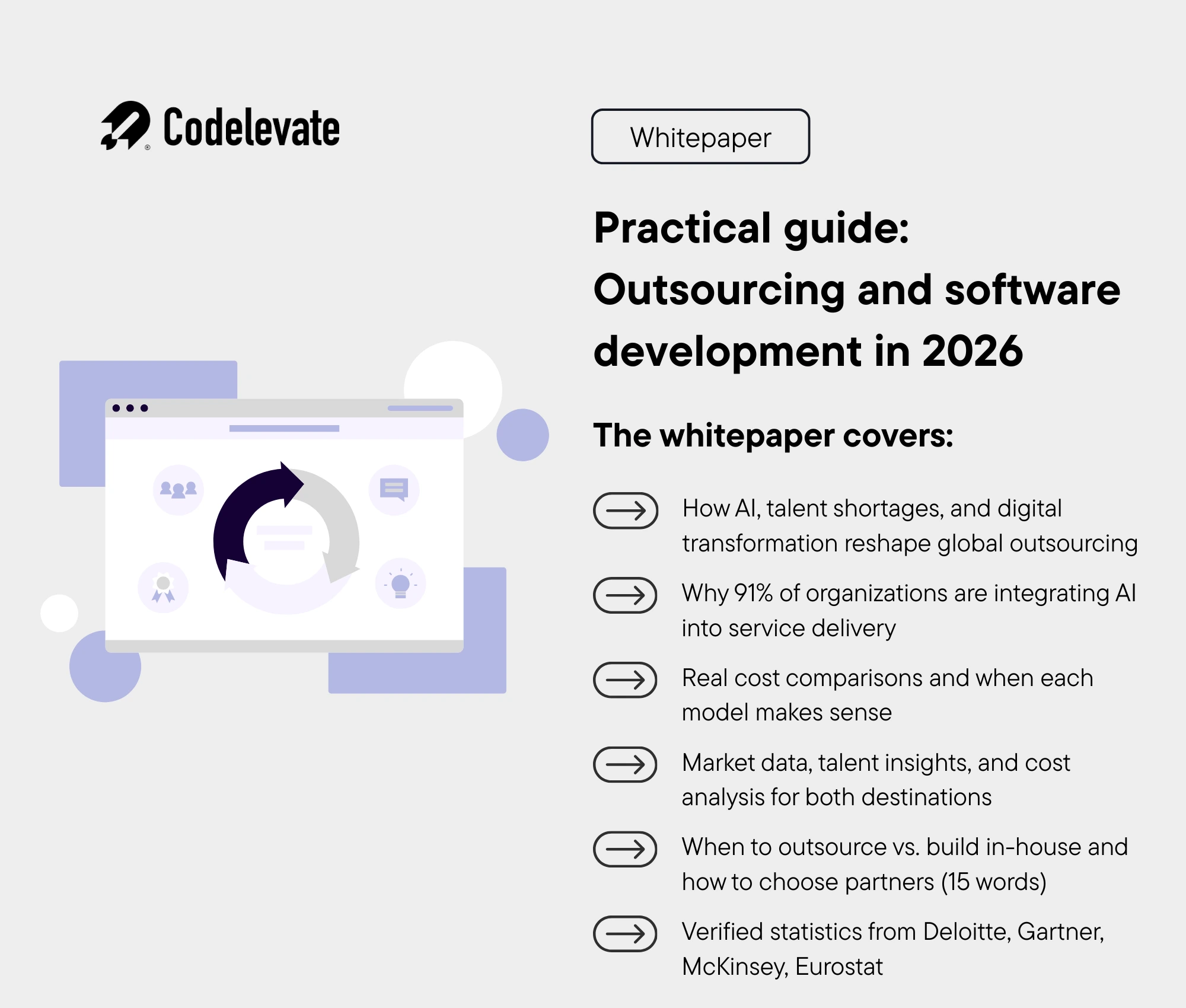
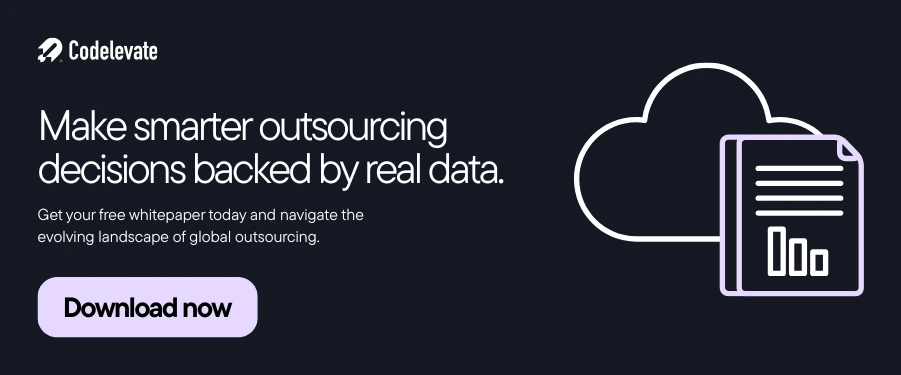
Why Codelevate is your best outsourcing partner
At Codelevate, we’re all about working closely with our clients to create high-quality, scalable solutions that match your business goals and timelines. We keep things simple with a fixed pricing model, so there are no surprise costs or scope creep along the way. With over 120 clients under our belt, we’ve got the experience to manage projects of all sizes. We’re also committed to data privacy and sustainable practices, so you can trust that your project is in good hands. Whether you're a startup or an established enterprise, our team’s expertise in SaaS and AI is always here to help you succeed.
So, if you need a reliable outsourcing partner, book a free strategy call with us and let's discuss how we can turn your vision into reality!





.webp)
.svg)




